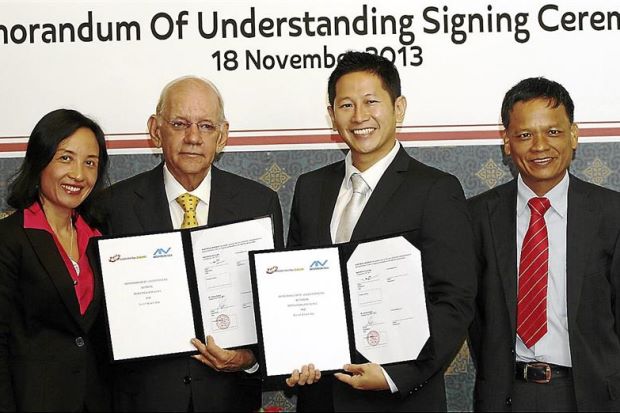
Illustration by Michael Byers
The Medical Tourism Boom
The Medical Tourism Boom
For decades, Patrick Follett beat the hell out of his body, taking to the mountain-bike trails five times a week and skiing more than 100 days a year. By the time Follett turned 58 last year, his left hip joint was a ragged mess of flayed cartilage, forcing him to limp around his job as ski-lift supervisor at California’s Snow Summit Mountain Resort and drop recreational skiing altogether. A surgeon told him he had sports-induced arthritis and would need a total hip replacement to get back to biking and skiing.
“With the insurance deductible, it was going to cost me $10,000 out of pocket,” says Follett, with the remaining $32,000 covered. Like some 1.6 million Americans did last year, he decided to go out of the country for a cheaper alternative. He found a reputable surgeon in Mexico who could do the whole operation for $10,000, covering doctors’ fees, room charges, and five days in the hospital – paid entirely by his company. Follett underwent surgery in Mexico in March 2012. One year later, he was back in action, able to ski 140 days in the season and, this past fall, complete a five-day, 335-mile cycling trip north to Mammoth Lake, California. “I feel better than I’ve felt in 15 years,” he says.
It’s an enduring national frustration that even insured Americans can’t afford many kinds of surgery. The average cost of a hip replacement, among the most common surgeries for active people under the age of 65, in the U.S. has nearly doubled in the past decade, rising from an average of $35,000 in 2001 to about $65,000 in 2011. Elsewhere you can get these surgeries with the same tools and equipment, and equally educated doctors, for as little as $6,500. Nearly all medical travel is elective. Therefore, the most common procedures, after dental and cosmetic surgeries, are cardiac bypass and arterial stents, hip and knee replacements, spinal disk repairs, and spinal fusions. Replacements are way more common than, say, ACL surgery because you’re likely to be more mobile and international travel is less burdensome. Thanks to the steady increase in the cost of health care in the U.S. – and the consequential growth of overseas hospitals catering to overcharged Americans – traveling around the world for life-changing procedures has become safer and more cost-effective and appealing for Americans than ever.
The Price of Surgery in the U.S.
Until a few years ago, most Americans going abroad for medical care were either uninsured or wealthy and traveling for cosmetic surgeries. But what you pay your insurance company, as much as 30 percent in some cases, has made going abroad a worthwhile option for a lot more people. For example, if a hip replacement in the U.S. costs $65,000 and you have to pay $19,500 (30 percent), then going to Costa Rica and paying $11,500 is a huge saving. In some cases, insurance companies won’t even cover a procedure if they consider it a preexisting condition, leaving you with the entire bill (the Affordable Care Act looks to do away with this still-common practice in 2014).
A handful of large insurance companies, like Aetna and WellPoint , as well as several smaller ones, have partnered with employers to offer international coverage as a way to trim premiums and save up to 90 percent on major claims. Most of these policies, however, are still in the experimental stage because insurers, employers, and workers remain skeptical of the quality of care and concerned about legal responsibility should something go wrong. For most Americans, the decision to go abroad for surgery comes down to simple math: what you would pay to have it in the U.S. minus the price of the international surgery and travel expenses.
The Rise of Surgical Tourism
Over the past decade, medical tourism has become big business, complete with packages, resort-like accommodations, and travel agents. There are now 100 or more specialty companies, like Planet Hospital , 360 Global Health , and MedVoy , that pair patients with overseas surgeons and hospitals, charging them a percentage of the overall procedure costs. They usually offer trips to major health care facilities – like Bumrungrad International Hospital in Bangkok, which serves 1 million patients from all over the world each year – and have dedicated outreach staff, Web portals, and overseas marketing campaigns. Bumrungrad and other similar facilities treat foreign patients, and their cash payments, like minor royalty. “Hospitals in Bangkok are like five-star resorts compared with us,” says Ralph Weber, who grew up in Thailand and is now chief executive of MediBid , a service that lets patients shop online for lower-priced medical care. “There’s one nurse for every two patients, and catered meals. It’s like walking into the Ritz-Carlton versus the Comfort Inn.” The rooms usually have kitchens, flatscreen televisions, and room service from local restaurants. Patients spend anywhere from a day to a week in the hospital recovering and being monitored before they are released. After recovery, most patients return home and begin post-treatment with local doctors and rehab facilities.
But much of the allure is the destination itself. Some 90 percent of U.S. citizens traveling overseas for medical care are sightseeing days before the surgery. Top destinations are Nicaragua and Honduras for the beaches, and São Paulo and Rio de Janeiro for the nightlife and culture. “If you’re going to a foreign country for a week of care, you’re bringing a companion and you both want to look around,” says Jonathan Edelheit, CEO of the Medical Tourism Association . “That’s one of the reasons this is growing.”
Booking Your Next Hospital Holiday
No surgery is without risk. That’s why people travel abroad most often for replacements – procedures with high success rates (up to 95 percent for hip and knee in the U.S.) and low risks of error or infection. Still, there are a few rules to follow when it comes to getting surgery abroad. The first is to go with a big hospital. “There are hospitals in India and Thailand that have a performance record as good as our best hospitals’,” says Dr. Peter Cram, a physician at the University of Iowa medical school who studies the costs of health. These countries’ best surgeons are often trained at major medical schools like Harvard and UCLA, or their equals in Germany and the United Kingdom.
But, as with hospitals throughout the U.S., quality varies. “What you want to look for first is a hospital that does large numbers of what you need,” says Cram. Also, you want to make sure the facility is accredited by the Joint Commission International , and find out some more about your surgeon by asking where he went to medical school and how many procedures he has performed, and by reading what former patients say online.
Make sure to take advantage of the many medical travel companies (see “Rules for Overseas Surgery”) looking to place patients in big hospitals, too, since they will have the most experience with the largest variety of surgeries. Jeff Wheeler, a construction worker from Maine, dislocated his left shoulder in the 1980s and some 20 years later needed a new one. At home, his surgery would have cost $60,000, and because it was a preexisting condition, his insurance wouldn’t cover it. Wheeler turned to the medical travel company PlanetHospital and arranged to have the surgery done at Piyavate Hospital in Bangkok for $10,000, plus airfare. He would pay for it using part of a workman’s comp settlement he had recently received from the accident.
Wheeler even attended a seminar at his local hospital on what to expect during and after joint replacement surgery. But he didn’t want to go halfway around the world “just to see the inside of a hospital,” he says. So he turned it into a three-week vacation, taking 10 days to first see Vietnam and Angkor Wat – before he went under the knife. “It was the best trip of my life,” says Wheeler.
Shopping for Domestic Deals
Not all affordable medicine requires an international flight – some of it is just over the state border. If you’re looking to shop around for better deals within the country, you’ll want to go to a company like MediBid. Since starting three years ago, MediBid has helped 2,500 patients find more affordable health care, saving businesses up to $1.5 million a year in the process by cutting out insurance companies, and with them a bloated, data-driven system that adds layers of cost to our nation’s $2.7 trillion yearly health care bill.
When you desire an elective surgery, you fill out a form with MediBid and it will come back to you with several quotes from doctors around the country and the world. Unlike an insurance company that takes 120 days to pay a doctor or hospital, the company cuts on-the-spot deals. “We go in and say we’ll pay $12,000 instead of $16,000, but the patient can pay at the time of service – no coding and no denial of service,” says MediBid’s Ralph Weber. “It’s a good deal for everyone. That’s why we’re getting good prices.”
This past June, MediBid helped Perry Hunt, a 50-year-old home developer in Orange County, California, get a new right hip in Texas. Hunt’s local surgeon said the operation would cost $100,000. Hunt was uninsured and did not want to pay that. MediBid had found quotes for India ($8,000), another hospital in California an hour from Hunt’s home ($14,450), and one in San Antonio ($21,000).
Hunt did not want to travel overseas. And even though the Texas surgery would cost far more than the nearby California alternative, he chose to go there because the doctor could perform the procedure with an anterior approach, going in through the front of the hip rather than the buttocks or side, and avoiding cutting through muscle, which makes for less trauma to the body and a speedier recovery. “It’s not always about the price,” says Weber. Hunt was back to playing golf within four months. “I was up walking the very next day,” says Hunt. “I was able to go home the day following surgery, as well, and was given exercises as my rehab. I couldn’t be happier with the results of my experience and the surgery.”
source: http://www.mensjournal.com / Mens Journal / Home> Health & Fitness / by Kevin Gray




